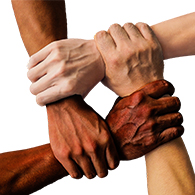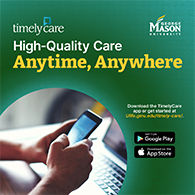By: Andy Ainsworth, Tiffany Nguyen, Morgan Outland, Hanan Isse, and Carsen Pracht, Mason students in the School of Business
“When we listen and celebrate what is both common and different, we become wiser, more inclusive, and better as an organization.” – Pat Wadors
Working toward an inclusive and diverse workplace is a key aspect of success for companies. While doing so, the entire company culture begins to shift to a more uplifting environment, which increases employee satisfaction. Here are the well-being benefits of workplace diversity.
How Workplace Diversity Benefits Well-Being
If employees are restricted within a close-minded and exclusive work environment, they are not able to reach their full potential. Companies that do practice diversity and inclusion are proven to be more successful and influential than those that don’t do so. “Diversity and inclusion make workplaces smarter and more successful, while also contributing to increased job satisfaction, employee retention and revenue,” this Cornell University executive summary says.
Diversity in the workplace allows for all people’s contributions to be included, giving diverse employees opportunities to use their talents and skills for the greater good. Also, diversity creates a better work environment that enhances productivity. Rather than looking for a “cookie-cutter” mold for a worker, looking to find those with varied viewpoints and different backgrounds leads to more productive conversations between coworkers, as well as more productive work overall – with each person free to make unique contributions to the company.
Diversity and inclusion have a positive impact on the future as well as the present. When a company shows it is an inclusive environment, that allows for easier recruitment of potential employees. According to a Deloitte survey mentioned in this article, 80 percent of more than 1,300 respondents said inclusion efforts were an important factor when choosing a company. It allows the employees to live a more balanced lifestyle which increases the quality of their well-being and mental health. As the Center for the Advancement of Well-Being notes, experiencing well-being allows an individual to lead a life of vitality, resilience, purpose, and engagement.
Employee Resource Groups
The need for an equitable environment in the workplace is essential for every organization. Employee Resource Groups (ERGs), which are increasingly popular, allow for much-needed employee support. Businesses and organizations are realizing the importance of diversity and inclusion and how some businesses are including ERGs as a strategic part of the organization. Of course, not all ERGs are the same. Having the proper structure with goals and outcomes promotes the success of ERGs. During coronavirus pandemic restrictions, many businesses had to find creative strategies to support their employees and to stay connected. Zoom and other similar platforms became very popular and useful as one of the strategies to allow employees a face-to-face experience. Colleges and universities also had to provide a platform to stay connected online.
As students at George Mason University, we can access Mason community well-being support resources through counselors, advisors, professors, and mentors. More importantly, culturally defined groups were able to target segments of the student community. The value of being heard and supported, especially for the underrepresented populations in organizations and schools, through ERGs “can ignite inclusion and are critical to the success of diversity initiatives in the workplace”, according to this McKinsey & Company article.
Challenges to Overcome
With the clear advantages of a diverse workplace, why doesn’t everyone just pursue it? There are many challenges when looking to achieve a workplace that is diverse.
One problem for a group of people from many backgrounds is communication. Likely, not everyone’s first language is English. There will also be different types of nonverbal cues people will use, depending on their cultural background. It is important for a workplace to set ground rules for how people will communicate, and encourage them to ask for clarification when something is not clear.
Also, hiring the right set of people is a whole different challenge. Employing someone just because of their background can be a flawed approach. It’s important to value the success of the organization alongside diversity when building a successful workplace.
The workplace itself isn’t the only place problems may occur. If upper management is not invested in implementing diversity, any effort made by those in lower positions will likely be moot. Support from those who make the company-wide decisions will always be a necessity. It is also important that management doesn’t pursue diversity only because it looks good on a company report. They have to be committed to support diversity with all their capabilities, but for the right reasons. If it just ends up as a token for companies to make themselves look better, there is no point at all as there is no promise it will be supported in the long run. Diversity isn’t just a departmental or specialized goal for a smaller section of the company. It must be an organization-wide effort.
More Progress to Make
Companies have recently attempted to develop more inclusive work environments, especially with the new implementation of employee resource groups. However, these endeavors are not enough, especially in light of the recent pandemic. Research has shown that many employees suffer from mental health issues, and mental health concerns are more prominent within diversity groups/settings. An example from the McKinsey & Company article is, “Employees who identify as lesbian, gay, bisexual, transgender, queer, or gender nonbinary (LGBTQ+) disproportionately fear losing ground at work and report feeling isolated. They report more acute work-related challenges than their straight and cisgender peers, including workload increases and stress over performance reviews, as well as a heightened loss of connectivity and belonging.”
Employee resource groups identify that diversity, equity, and inclusion are important. These groups need to highlight that diverse groups bring a wide range of different needs, though. Therefore, companies should try their best to accommodate all and consider everyone and every group in their decision-making.
Additional Resources
Learn about the barriers to, and the benefits of, diversity in the workplace in this Western Governors University blog.
Explore well-being research on what makes a workplace diversity program successful in this Greater Good Science Center article.
Read motivational quotes on diversity and inclusion in this Mason article.
Learn more about promoting a diverse workplace environment from Mason’s Office for Diversity, Equity, and Inclusion.
Write one of these Thriving Together Series features! We’re looking for contributions on all topics related to well-being. Read other Thriving Together Series articles here and contact us at cwb@gmu.edu for guidelines. Thank you for helping our Mason community thrive together online!






















